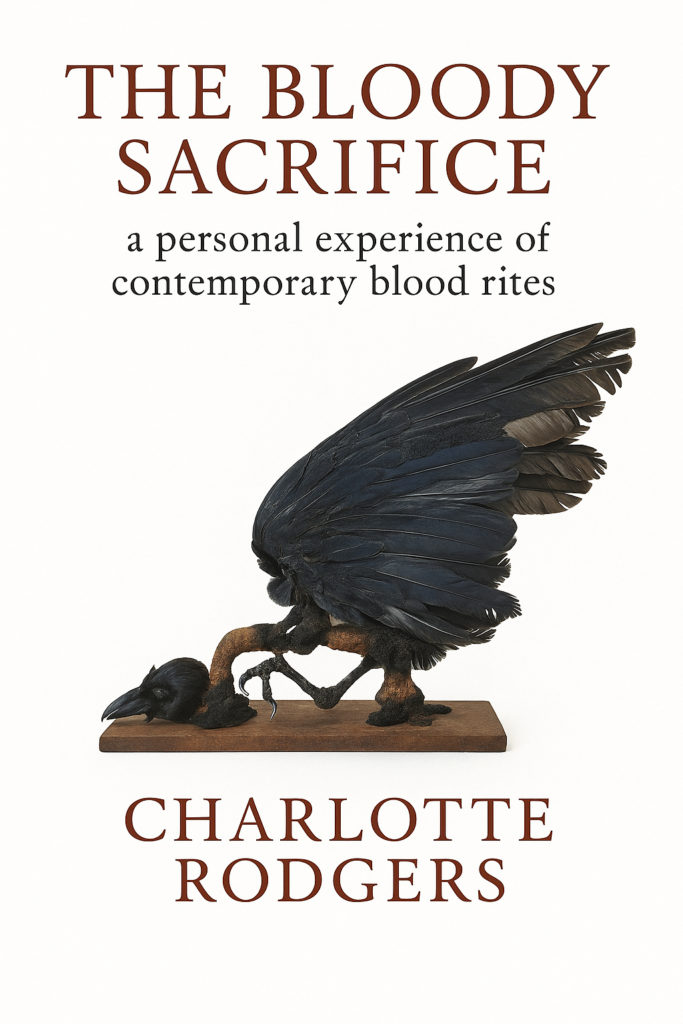
Tag Archives: Spirituality
Pagan Heart of the West
Featured
Vol. I
Randy P. Conner PhD
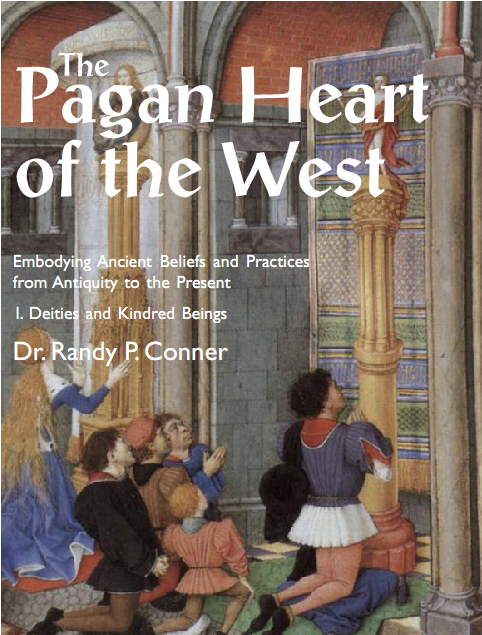
The Pagan Heart of the West challenges current academic notions that paganism died when Christianization occurred; that the transition from paganism to Christianity was a fairly easy, nonviolent one; that persons once pagan were happy to accept the new religion because it fulfilled them or because they viewed it as superior – as if the Inquisition never happened; and that all things pagan are in fact Christian prior to the mid-twentieth century, even though they demonstrate little or no connection to the Christian New Testament. Likewise, Pagan Heart challenges narrow conceptions of “the West.”
The Pagan Heart of the West:
Embodying Ancient Beliefs and Practices from Antiquity to the Present
Volume I “Deities and Kindred Beings”
Randy P. Conner PhD
ISBN-13: 978-1906958879
£20.00+p&p / US$28.00+p&p
Orders over £50 ($75) get free shipping
Click here to Buy UK edition
Click here to Buy USA & Elsewhere
Click HERE to buy the Pagan Heart of the West Quartet / £65 post free UK
Click HERE to buy the Pagan Heart of the West Quartet / $93.00 post free USA
Applying Indigenous and decolonial theories, together with Michel Foucault’s conception of subjugated knowledge, Pagan Heart suggests that instead, paganism should be explored as an ancient and indigenous set of common beliefs and practices, at once ubiquitous and local, that includes the reverence of deities; the veneration of nature; rites celebrating the seasons and the life cycle; practices of healing, divination, and magic, often guided by ritual specialists; and arts and philosophies giving expression to pagan figures, concepts, and narratives.
In this first of five volumes, Pagan Heart focuses on the utilization of theories that contest absolutist language supporting the so-called death of paganism; and on the worship and veneration of ancient deities and kindred beings. Like the other volumes, this volume demonstrates that paganism has not only persisted over the course of millennia but that it has also undergone metamorphosis and innovation.
Most importantly, Pagan Heart emphasizes that the ancient gods did not die when Christian authorities forbade their worship and sought, in N. Scott Momaday’s terms, to commit deicide, but instead that they continue to exist and thrive.
Randy P. Conner, Ph.D., is the author of several works on the intersection of gender, sexuality, mythology, and the sacred. He teaches Humanities, including World Mythology, in the Chicago area.
cover: Barthelemy d’Eyck, Emilie, Arcitas, and Palamon Praying to Their Respective Gods (c. 1465), illumination from Boccaccio’s Il Teseida Delle Nozze d’Emilia.
In this first of five volumes, Pagan Heart focuses on the utilization of theories that contest absolutist language supporting the so-called death of paganism; and on the worship and veneration of ancient deities and kindred beings. Like the other volumes, this volume demonstrates that paganism has not only persisted over the course of millennia but that it has also undergone metamorphosis and innovation.
PantheaCon 2020
Stop Press!!
Dr Randy P. Conner, author of The Pagan Heart of the West will be speaking at
The Final PantheaCon
Friday, February 14 – Monday, February 17, 2020
at San Jose Doubletree Hotel,
2050, Gateway Place,
San Jose, CA, USA.
For full details, speakers program and to book go to their website pantheacon.com/wordpress/
Email: info@pantheacon.com
Upperworld
Featured
Shamanism and Magick of the Celestial Realms
Chris Allaun
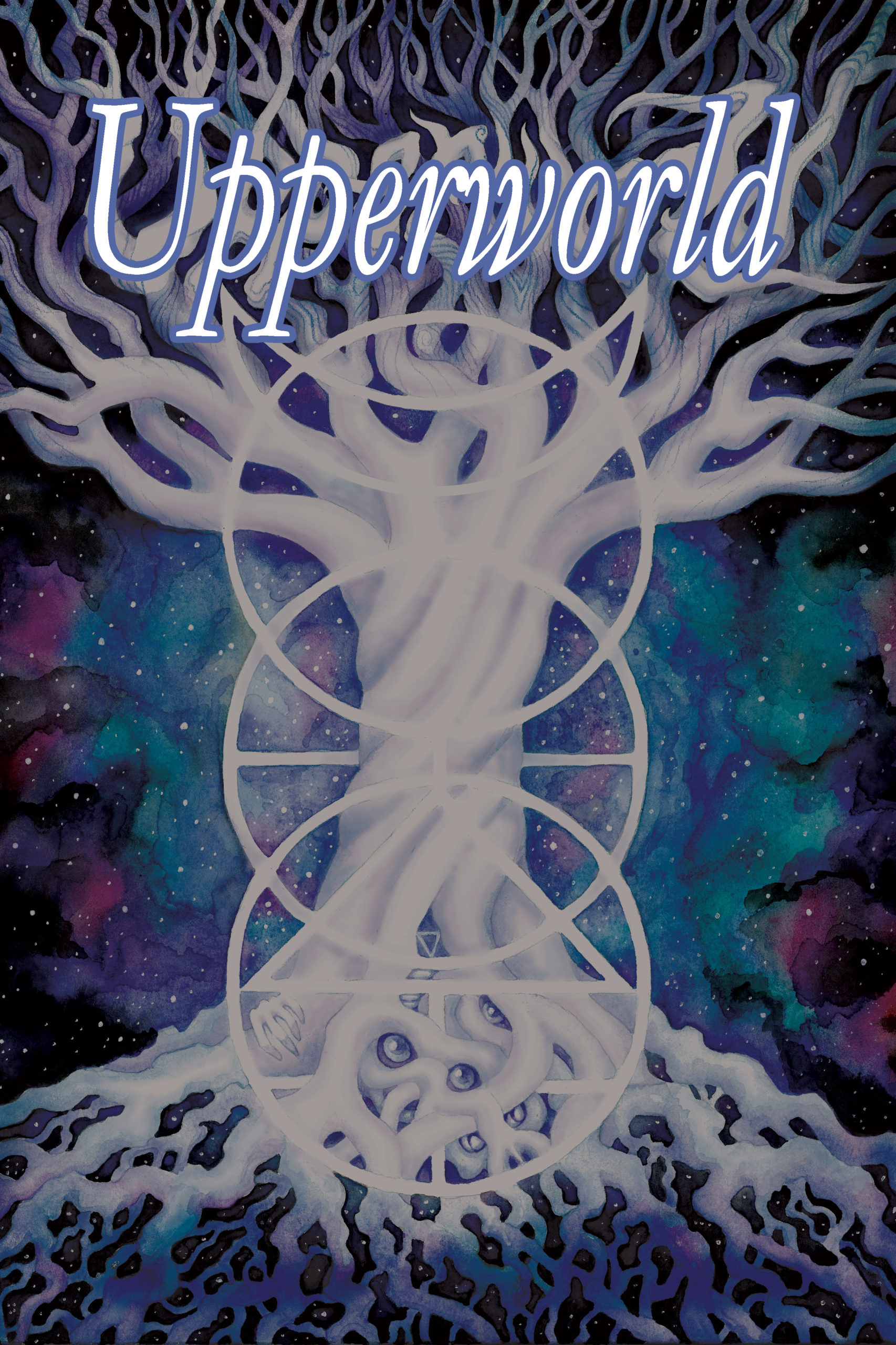
Upperworld: Shamanism and Magick of the Celestial Realms
Chris Allaun
ISBN: 978-1-906958-92-3
Format: Softcover
£15.00 / US$24.00
Subjects: Angels/Magick/Shamanism/Myths/Healing/Spirituality
Click HERE for Upperworld / UK
Click HERE for Upperworld / USA and AUS
The stars glow with their own special magick in the nighttime sky. For millions of years, the stars sent their light down to the earth. The same stars and planets we see today are the same bodies of light that ancient shamans saw around their campfires. Countless generations looked into the night sky and wondered about the magick above. It was the shamans who travelled in spirit to the Upperworlds to discover the secrets of the Universe. There are many ancient beings in the above worlds that can help us learn about the energies of the Universe and transform our lives for healing, power, and spiritual evolution.
As we journey into the Upperworlds, we will learn about the creation of the Universe and the energies that were formed from the first burst of energy and light. Shamans saw that these energies formed into powerful beings. Some called these beings angels, others called them ascended masters. Each of these beings has a divine purpose in the Universe and we will unravel these mysteries. We will learn to spirit travel into the many heavens from many different cultures. We will visit the heavens that were told to us in myths, as well as discover hidden parts of the Universe that await our arrival. We will also learn about the gods and goddesses and how to honour them in our daily magical practice. The gods are powerful and they can grant us many blessings. Through our magical practice with the night sky, we will use the magick of the stars and planets to transform our lives and the physical world around us.
“Like those before him, Christopher Allaun steals a little bit of the fire of heaven and shares it with his readers. While the underworld might be more in vogue these days, he tackles the rich lore of the heavens, and shares practical teachings that can be brought down to Earth for when you want to seek the stars.”
– Christopher Penczak, Co-Founder of The Temple of Witchcraft and author of City Magick, The Witch’s Shield and The Mighty Dead.
“Chris Allaun’s new book, “Upperworld”, is a very interesting and informative read. Consistent with his previous work, Chris focuses on the myths, legends and spiritual teachings of an eclectic mix of cultures from around the world, giving insights into their ways of viewing the “higher” realms. Chris gives information on the Shamanic worldview and the place of the Upperworld within it, detailing techniques to access and explore its various realms. Drawing on diverse sources, he not only describes the denizens of the various realms of the gods, angels, stars, planets and kabbalistic worlds but gives practical information on how to make contact and interact with them. There are rites of worship, magic, devotion, astral projection and healing that not only give an insight into the practical working of pagan, Shamanic experience but enable the reader to experience these themselves and take their own journey along the Shamanic path. This is an accessible and approachable work, both for the newcomer to the subject and the more experienced practitioner alike; both will derive benefit from reading this book.”
–Nigel G. Pearson, author of Treading the Mill: Workings of Traditional Witchcraft and The Devil’s Plantation: East Anglian Lore, Witchcraft, and Folk-Magick.
“Ancient shamans didn’t spend all their time journeying through the hazards of the underworld. They also took time to explore the heavens (or “Upperworld”), to learn the mysteries of creation, healing, and magick directly from the gods. It is refreshing, in this time when goetia is given so much focus, to see the author’s exploration of the concepts and spiritual beings of the celestial realms. Just as important, his focus upon lore, legend, and mythology in developing a true understanding of and shamanic relationship with these beings is vital, and often missed in modern Western occult texts.”
– Aaron Leitch, author of Secrets of the Magical Grimoires: The Classical Texts of Magick Deciphered and The Essential Enochian Grimoire: An Introduction to Angelic Magick from Dr. John Dee to the Golden Dawn.
Check out Chris Allaun’s news, classes, workshops and other events-
Chris Allaun: Author, Teacher, Healer
https://www.facebook.com/chrisallaun.author/?rc=p
Heart Vision: Tarot’s Inner Path
Featured
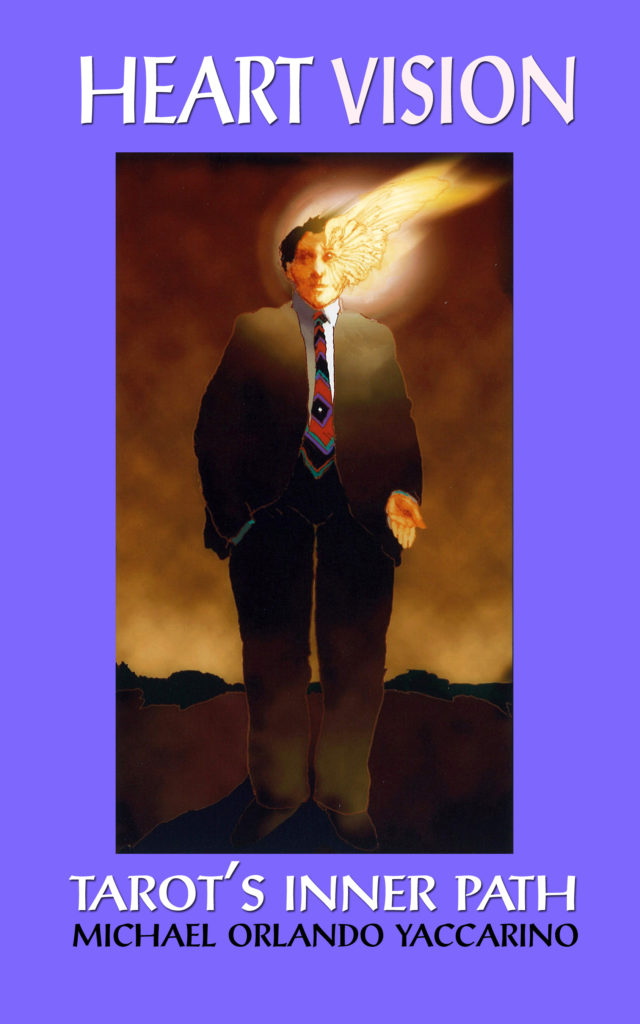
Michael Orlando Yaccarino
Foreword by Rachel Pollack
Afterword by Normandi Ellis
Format: Softcover
ISBN 9781906958817
£15.00+p&p / US$24.00+p&p
Click Here for USA edition
Click HERE for UK edition
Click here for Kindle UK edition
Click here for Kindle USA edition
—————————————————————–
Each of us is travelling upon an ever-evolving path toward greater illumination. The Tarot can provide deep awareness on many levels. Performed effectively, a Tarot reading encourages individual strengths, while proposing options to overcoming unhelpful blocks. Revelation unfolds within the open heart.
The mystical deck has fascinated both nonprofessional and paranormal scholars alike since its early development in the 15th century. Today, a myriad of books on using the cards to read to others is readily available. However, few works focus exclusively on the process of self-reading. Heart Vision: Tarot’s Inner Path is your in-depth, hands-on guide for a balanced path of discovery through the art of solitary reading.
Highlights include card-by-card message interpretations; a special focus on self-contemplation; the step-by-step process of self-reading unique to this work; and a variety of simple yet powerful spreads utilizing no more than six cards original to this book, many illuminated by actual self-readings. World-leading Tarot authority Rachel Pollack provides an insightful foreword. Award-winning author and specialist in Ancient Egyptian spirituality, Normandi Ellis offers an illuminating afterword. In addition to the wisdom of diverse spiritual traditions, the text includes exclusive comments by a variety of contemporary luminaries in the realms of the mystical and magical. And acclaimed artists Scot D. Ryersson, Gary Lund, and David Palladini all contribute to the book’s stunning illustrations. Enriched throughout by the wisdom of diverse spiritual traditions, in these pages, you will find an innovative pathway to inner transformation.
Front-cover art: Gary Lund
Back-cover art: David Palladini
Cover design: Scot D. Ryersson
The author has read, taught, and written about the Tarot for many years. He holds degrees in psychology and film studies from New York University. Previous books co-authored with Scot D. Ryersson include Infinite Variety: The Life and Legend of the Marchesa Casati, The Marchesa Casati: Portraits of a Muse, and The Princess of Wax: A Cruel Tale. Also with Ryersson, he co-edited Spectral Haunts and Phantom Lovers.
Visit the official Heart Vision website
Heart Vision: Book | Michael Orlando (casatiarchives.wixsite.com)
Book Reviews:
“Probably one of the best books on the Tarot that I have ever read. A must for all Tarotists.” —Anthony Pearson-Moorhouse, The Elvish Taylor and Owner/Partner of Sacred Earth (Suffolk, United Kingdom)
“Yaccarino’s approach to the Tarot is direct and invigorating, with the emphasis on self-reading. As a rule of thumb, I often test the inherent magickal quality of any such tome by opening it at random and letting my eye alight on the first words I see. In this case, the book opened at the King of Cups, which was disturbingly accurate. With the attitude of ‘Okay, but what else can you tell me?’, it then opened to the Nine of Pentacles. Again, exquisitely apt. In essence, with this clear and lucid book, you can know it works.” —Alan Richardson, author of numerous books on magick, magicians, and Earth mysteries, including Priestess: The Life and Magic of Dion Fortune and Earth God Risen
“A beautiful book, flowing and inviting, presented with an openness and clarity in both writing and visuals.” —Gary Lund, award-winning painter, sculptor, and animation film designer
“It is through the imagery of Tarot that Yaccarino explores each of the arcana. As Heart Vision unfolds, Michael skillfully guides us through the deck, deftly bringing our attention to the hidden, background imagery and the ‘veiled aspects’ of each card. But it’s not all about the iconography: a comprehensive range of spreads are given, with some very interesting variations. There are also examples of readings that demonstrate how the interpretative process unfolds. Little gems of wisdom are scattered through the pages, culled from Yaccarino’s clearly extensive reading and conversations with contemporary practitioners. This is an excellent introduction to the Tarot, and an enjoyable and illuminating text for the seasoned reader, too.” —from The Blog of Baphomet by Julian Vayne, author of Deep Magic Begins Here…: Tales and Techniques of Practical Occultism and Magick Works: Stories of Occultism in Theory and Practice
“The introduction to this book is penned by the renowned Tarotmancer Rachel Pollack. She describes this book as one of ‘distilled simplicity,’ designed for the apprentice but which has sufficient maturity and depth for seasoned readers too. It is focused on the solitary reader for self-analysis, offering a unique approach to the visionary dreaming world to nourish heart and soul by awakening the mind. After a brief but concise history of the Tarot, Michael leads the reader into a vivid perspective of mystical imagery as the art of vision within Reality. It serves as a potent tool, drawing the reader to attend the hermetic sciences and its philosophies to fulfil a divine purpose—not as amusement or entertainment. The pursuit of wisdom is ever the key. Emphasising the distinctions of revealed and veiled messages, it explains how these build upon one another to synergise profound insight. Michael provides a break-down of the Arcana into elemental suits, injecting innovative expression into their multi-layered symbolisms. He then introduces several original spreads providing unique formats, including those aptly named ‘The Crossroads’ and ‘The Bridge.’ Ranging from a single spread to six cards, they encompass all needs and situations, guiding the reader always towards decisive understanding and self-awareness as a means of access to their inner dialogue. Intent is captured at source. The reader is made aware of the folly of this tool as a means of prediction, a waste of soul talent that erodes free will and hope. Instead, it instils hope through the engagement of the sacred harmony that can be achieved through self-expression and fulfilment. With lucid equanimity, Michael directs the reader to engage that precious dynamic to manifest the message as translatable instruction. Using multi-disciplinary techniques, the ‘happening’ Michael refers to becomes a transformative engagement of the mysteries proper through the miraculous art!” —by Shani Oates, author of The Devil’s Crown: Key to the Mysteries of Robert Cochrane’s Craft and The Arcane Veil: Ten Discourses on the Craft and the History of Magic
TAROT, DIVINATION & SPIRITUALITY
Underworld
Featured
Shamanism, Myth, Magick
Chris Allaun
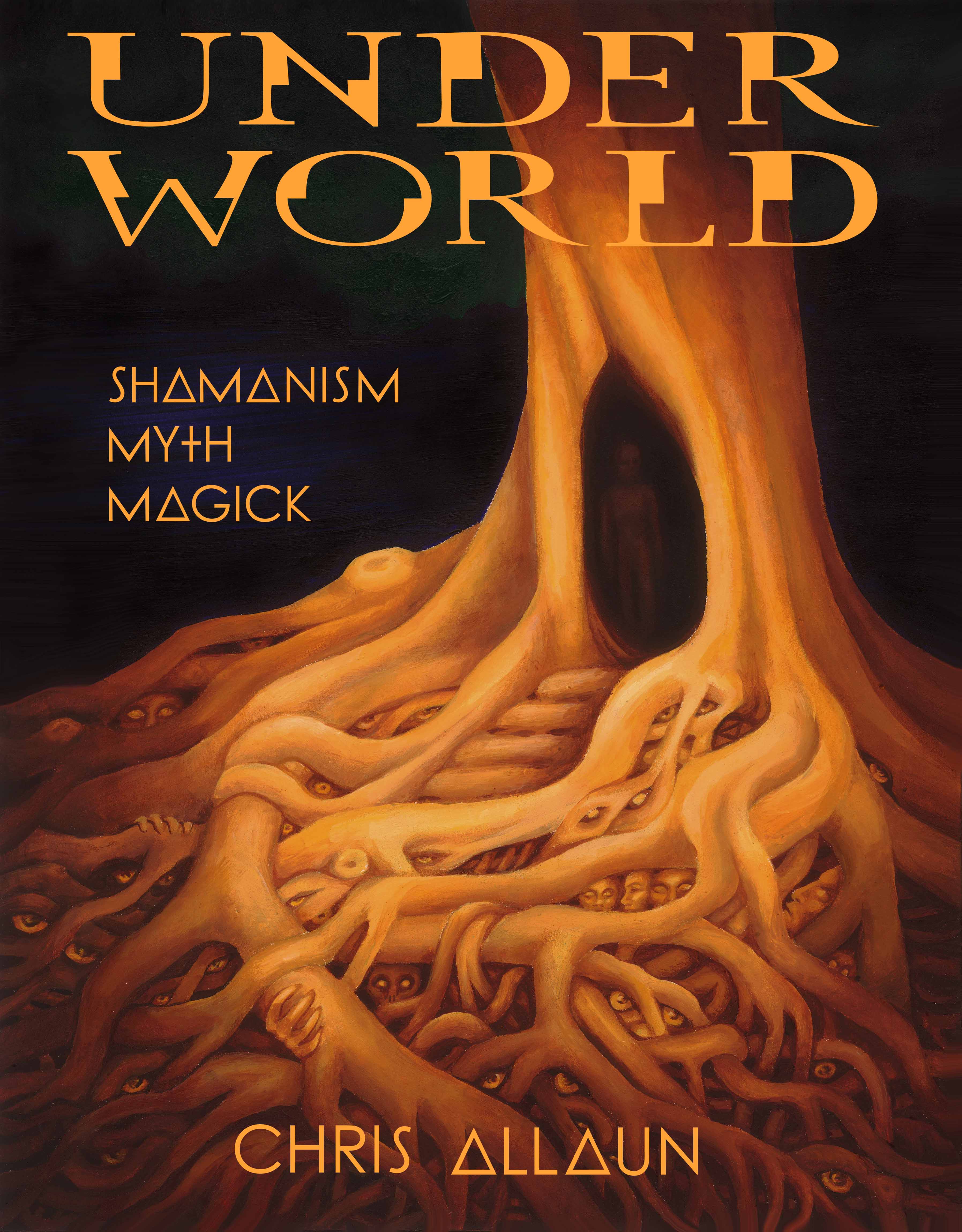
Underworld
Shamanism, Myth, Magick
Chris Allaun
Format: Softcover
ISBN: 978-1-906958-76-3
£15.00 / US $24.00
Click here for Kindle UK edition
Click here for Kindle USA edition
– Synopsis –
The Underworld has always been thought of as a place of darkness and despair. Even today there are many misconceptions about what the Underworld is and what awaits inside. We will learn how different cultures around the world viewed the Underworld and the afterlife. Some cultures have there own unique perspective, but surprisingly, cultures that had no communications with each other form across the world had similarities. Can this be a coincidence? Most importantly, we will learn how to journey there in the astral and map this incredible world. But be careful! Along with its many wonders and beauty, there are things that lurk in the dark that myths throughout the ages have warned us about. But for the Shaman or witch, are these warnings to keep us away or teach us how to commune with these ancient spirits and creatures?
As we journey deeper into the Underworld, we will discover places where the long-forgotten dead will rekindle our spirit and teach us the ways of magick. They have been waiting for us and have much to say. We only have to sit and listen to the wisdom of ancient times. We will also discover places of healing and rejuvenation. Places where ancient hags guard magick wells and the waters of life and death spring from a source so old, no one remembers where it came from. Along with these wonderful and beautiful places, there are places most dark and dreadful, the Hellworlds. These are the areas of the Underworld that test your spirit and what you thought was reality. You may never be the same, but you will be transformed, renewed, and more powerful.
The Underworld is strange and wondrous and cannot be contained. Sometimes, those spirits of the dead will not be bound in such a place and stay in the world of the living. The poor lost spirits stay with us for a variety of reasons. You will learn why the spirits of the dead are still here and how to help them journey to a place of rest. You never know, a spirit of the dead may be right behind you…
”Chris Allaun’s book, Underworld: Shamanism, Myth, and Magick is truly a masterpiece. Chris has thoughtfully taken a huge subject and separated it into readable and manageable sections and chapters. He clarifies –What is the Underworld? Who resides in the Underworld? Where is the Underworld? and Why does it exist?” — all questions that have fascinated mankind since the beginning of time. And Mr. Allaun gives the reader exercises to deal with the dark side of the underworld, practical ways to cope with exploring one’s own fears and terrors, along with ways to help others. He also includes an extensive bibliography, something very useful. From psychologists to ceremonial magicians to spirit workers, to people just trying to navigate today’s complex world, Underworld creates a clear path full of information and help, to guide us through these often troubling times. I highly recommend this book!”
– Janet Barres
Cover art/design Amanda Manesis
Chris Allaun: Author, Teacher, Medicine Man
P is For Prostitution
Featured
An A-Z of a harsh life survived
Charlotte Rodgers
Illustrated by Ruth Ramsden
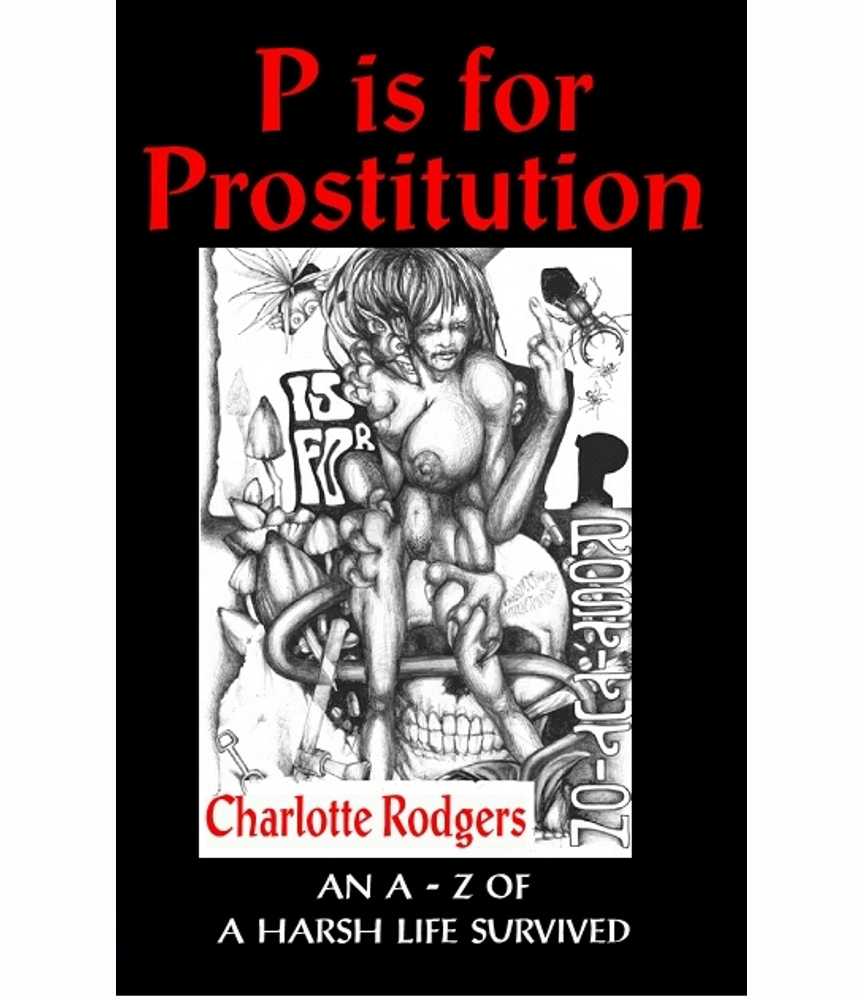
P is for Prostitution
An A to Z of a harsh life survived
Charlotte Rodgers
ISBN: 978-1-906958-26-8
£15.00 +P&P /US $24.00 +P&P
Click HERE for UK
Click HERE for USA & AUS
Click here for Kindle UK Edition
Click here for Kindle USA Edition
P is for Prostitution is a primer unlike any you will have read before, the ABC approach far from simplistic. Through various episodes the author charts her own insights into addiction and the kind of existence that inevitably goes with this. Each letter marks a step on a journey into the lowest circles of hell in which the “author’s creativity and intellect is misdirected towards a chaotic, nihilistic and devastating existence” (reader’s foreword). There are moments of black comedy, sexual horror, and final, uneasy redemption in which the author reclaims the trajectory of her life.
“. . . the life you lived . . . represents the era you grew up in and the position of women in society and the rules they were expected to live by and the consequences of breaking these rules. Women are often regarded as objects, possessions and are expected to be submissive.” (Jane Hunt)
P is for Prostitution grew out of the author’s exploration of death and ancestral cults. It led her to acknowledge her own past, re-connecting and rescuing a catalogue of youthful dead or missing loved ones. “This was no surprise given the way we lived our lives at that time, but was no less saddening. Whilst the people concerned were not blood relatives, they were part of who I was and very much my family of choice in our shared inability or refusal to accept the terms of mainstream existence.”
“Daddy was an exclamation mark /
exploding on blank walls /
I was a biblioteque hero /
supporting Atlas’ balls /
Roller skating on Freudian slips /
Pussy footing through the fly leafings/
Of fellow social misfits.”
———————-
“Charlotte Rodgers was born in New Zealand.
Her mother was a war baby, abandoned at the Home of Compassion in Wellington and later adopted by a middle class couple with strong Catholic sensibilities and a desire to do good and moral things; a desire that didn’t encompass compassionate and kind child rearing.
Charlotte’s father was Scottish and from a coal mining family, he escaped this background through self education and by joining the merchant navy, and whilst on leave in New Zealand he met and married Charlotte’s mother.
Charlotte was brought up by two creative, intelligent and unstable individuals whose backgrounds created unhappiness and various manifestations of addictive and compulsive behaviours.
The family constantly moved house, the mother was addicted to a huge amount of pills, the father would regularly ‘run away from home’ and there were many times the only stability in Charlotte’s life was when she was sent to live with her grandmother who was rigidly and violently Catholic.
Charlotte was a shy frightened and introverted child and puberty hit her like the proverbial ton of bricks. At age 15 she made several suicide attempts and was put into psychiatric care to be treated for bulimia, a condition that would stay with her for many years.
She also developed addictions to alcohol and drugs, including heroin, and necessarily worked as a prostitute to fund the habit whilst living a peripheral existence travelling through Australia, Asia and Europe, before settling in England.
After 19 years as an active addict (15 of them as an IV user) she cleaned up with the help of various institutions and agencies, and eventually was able to take the risk to go back to what she always wanted to do; creating art and writing.”
Charlotte is author and editor of The Bloody Sacrifice and
co-editor of The Contemporary Western Book of The Dead, both published by Mandrake.
——————-
Illustrated by Ruth Ramsden
——————–
Daddy was an exclamation mark, exploding on blank walls,
I was a biblioteque hero, supporting Atlas’ balls,
Rolling skating on Freudian slips,
Pussy footing through the fly leafings
Of fellow social misfits.
Well read, intellectually fed neurosis,
Genetically perfected psychosis
Penis Envy
Poison Ivy
Piss and Raving.
Something in the woodshed gave you a fright,
Rumplestiltskin will tell you anytime
Its prick is worse than its bite.
Go-go virgins in discotheque cages
Venus in politically unsound furs
Lectures on the latest psychoanalytical magus
Romulus Remus Oedipus
Sucking dugs like common curs.
Psychoanalyse, disembowel and theorise,
Penis Envy Poison Ivy
Something in the woodshed gave you a fright,
Rumplestiltskin will tell you anytime,
Its prick is worse than its bite.
C.Rodgers 1985
Vowels, Consonants and Other Building Blocks: An Introduction
Several years of exploring and writing about death and cults of the ancestors have led to my putting this, more personal book together. As I looked at how necessary acknowledgement of the past can be to solidify the sense of self, both as an individual and a member of a community; flashes of my own, personal history came back to me. I started to re connect with this and found a catalogue of youthful dead and missing loved ones. This was no surprise to me given the way that we lived our lives at that time, but was no less saddening. Whilst the people concerned were not blood relatives, they were part of who I was at that time. They were very much my family of choice in our shared inability or refusal to accept the terms that mainstream existence at that time offered. I decided to reclaim this time and a lost part of myself, by going back and recording some of my rather erratic recollections.
Initially I was worried that writing this could be self-indulgence or an exercise in personal exploration and poor man’s psychoanalysis that shouldn’t be put out to a wider audience.
However the times and places I lived in, and the way I experienced them, hold things which I believe are core to many who struggle to find their place in this strange world.
Putting such a chaotic mass of events into order could have proved an impossibility until it became apparent to me that my early years were very much about finding a set of rules to live by, thus the subtitle, ‘A Modern Primer’.
Using the alphabet to give order to these memories was a continuation of the primer concept and works well for me. My life was not lived in a straight line and my rather scrappy memory would have rebelled against too linear a form of organisation.
The time span this book encompasses is the 1970s to the 1990s and the backdrop moves between Hong Kong, Australia, London and New Zealand.
This was a time when digital watches were rare and expensive things; China was hard line communist and undeveloped; the Internet was unheard of and there was still a wall dividing Berlin. Graphic novels were on the ascent; only the super-rich had credit cards, and AIDS was just a whisper that could kill in its utterance.
When I was diagnosed with bulimia it was a relatively unknown condition that the medical establishment were unsure how to approach.
I cleaned up as crack was just starting to make its presence known and I was already seeing changes it had made in the junkie community.
Drug using rapidly became even more associated with violence, users burned out much more quickly, if they survived.
When I stopped using drugs I was 30 and considered relatively young in the ‘recovery’ community, but 18 years later I see women burned out by the time they are 15 or 16.
I was one of the first waves of people to go into drug and alcohol rehab, and sad to say the women’s only treatment centre I was in, due to lack of funding, no longer exists.
However the core of the experiences in this book isn’t era specific but is more about one individual’s rather rocky road through her early years.
One thing that I feel I should add.
Readers may find my tone to be detached and even perceive a certain lack of emotion. I was and still am an internalised person, something that may have led to some of my problems over the years.
I look at old photographs of myself and I see a lovely looking girl who seemed locked in her own world. Eventually I couldn’t stay in that private place anymore, despite ever increasing amounts of emotion suppressing drugs. When I left rehab I had a graduation of sorts, a ceremony where I was presented with a butterfly brooch. As I was given my pin, Sister Rosemary who ran the home said that when I arrived at the facility I was like the survivor of a serious car crash; locked in trauma.
Walking away from my car crash life, with its explorations, adventures, and ever increasing horror was when I really started to live.
It was a very different world then, but in many respects, the way we all live and develop has not changed at all.

Reader’s Comment
‘P is for Prostitution’ is a personal memoir, which explores episodes and experiences from Charlotte Rodgers’ difficult chaotic life, through her childhood and into early adulthood. At times this book made me feel incredibly sad and much of it was alien to my own comfortable, relatively trouble-free youth. However, her story captivated me and I found myself wanting to find out more about the girl being described. Also, as a woman who grew up during the same decades, I recognized the underlying misogyny of the era and the rules that women were expected to observe. Both Charlotte and her mother suffered in different ways because they were unable to live within narrow definitions of womanhood.
The Primer structure works particularly well and gives the impression of bringing order to a fragmented and chaotic existence. It comments on the nature of individual memory that is not linear and makes connections between disparate incidents and episodes. This form enables the reader to think for herself and reflect on how Charlotte’s childhood and formative experiences affect her situation as she grows up.
Throughout P is for Prostitution, despite the chaos of a life dominated by addictions and illnesses, Charlotte remains a creative and intellectually curious person. Her attraction to similar damaged anarchic souls both as friends and lovers can be seen at various points in her book. Near the end she refers to ‘the person from Porlock’, a debt collector who interrupted Coleridge whilst he was writing Kubla Khan. Charlotte writes, “I feel as if I too had a debt collector knocking on the door of my life, and breaking and permanently redirecting my concentration.” The book conveys a real sense that Charlotte’s creativity and intellect was somehow misdirected at a young age towards a nihilistic and savage existence. It also traces the constant, durable thread of spirituality in her life. This is fascinating given her early encounters with Catholicism.
The book powerfully communicates the devastating effect of physical and mental abuse on Charlotte’s whole family. The suffering her parents endured as children impacts on Charlotte’s life and leads to a lack of stability and security when she is growing up. Charlotte too is terrorized as a child whilst under the ‘care’ of her Grandmother. The sexual repression, religious fanaticism and cruelty that lie behind this abuse are horrifying. Children’s lack of power and the lasting consequences of adult neglect and brutality are recurrent themes.
The reader is able to observe how Charlotte’s eating disorders are caused by a desire to gain some control and how the perception that thinness equals happiness and acceptance actually appears to have almost the opposite effect. This is something that all women can relate to at some level. The book also gave me an insight into addiction and the kind of existence that inevitably goes with it. Her experiences are distinctive but they do reflect the times she lived in and the alternative lifestyle that seemed to be offered by the world of drugs and music. The attraction of losing control and finding a different reality is explored. However, the destructive power of addiction ultimately makes life unbearable.
Charlotte’s discussion of sex in P is for Prostitution is thought-provoking and brave. Her unconventional attitudes and approach made me think hard about the way women are condemned and vilified for sexual transgressions. Moreover, it made me consider how women and children are so often the victims of abuse and the hypocrisy that existed about this when we were growing up and still does to a large extent. Women who transgressed the sexual norms or accepted codes of behaviour were seen as to blame for the abuse they suffered, rather than as victims.
Fundamentally, this is a fascinating articulate and engrossing book. It describes experiences and feelings with which many people, especially women, will identify. I think people will enjoy Charlotte’s honesty and will want to read on and find out how she manages to get through and eventually change her life permanently. Charlotte takes you into divergent worlds, often frighteningly disordered; but the creative, compassionate and intelligent woman that she is today, is always there despite the destructive forces in her early life.
Jane Hunt
Librarian
Somerset
*************************************************************************
Shape-Shifters & Their Stories
Featured
The Golem; Lilith; Werewolf; The Dybbuk; Silkie; and more
Michael Berman

Shape-Shifters & Their Stories
Michael Berman
Format: Softcover/192 pp, 24 fascinating Illustrations.
ISBN: 978-1-906958-66-4
£15.00 / US$24.00
Subjects: Folklore//Myths & Magic/Fairy Tales/Shamanism/Spirituality.
Click HERE for Shape-Shifters & Their Stories / USA
Click HERE for Shape-Shifters & Their Stories / UK
“Long ago the trees thought they were really people
Long ago the mountains thought they were really people
Long ago the animals thought they were really people
Someday, they will say
Long ago the humans thought they were really people”
Constance O’Day-Flannery, Shifting Love
Shape-shifting is a common theme in mythology, folklore, and fairy tales. In its broadest sense, shape-shifting occurs when a being (usually human) either (1) can change its shape into that of another person, creature, or other entity or (2) finds its shape involuntarily changed by someone else. If the shape change is voluntary, its cause may be an act of will, a magic word or magic words, a potion, or a magic object. If the change is involuntary, its cause may be a curse or spell, a wizard’s or magician’s or fairy’s help, a deity’s will, a temporal change such as a full Moon or nightfall, love, or death. The transformation may or may not be purposeful.
The desire to be different in some way to match some ideal promoted through advertising has become an obsession, especially for vulnerable younger members of society. Perhaps the pressure to conform to some unrealistic ideal has always been with us, but surely not to the extent that now is the case. And it is this desire that helps to account for the current interest in shape-shifting as it would seem to provide a means of achieving the goal to bring about change. However, as many of the tales in this collection show, it is only by coming to terms with who we are that peace of mind can truly be ours again.
Secret Gospel of Mark
Featured
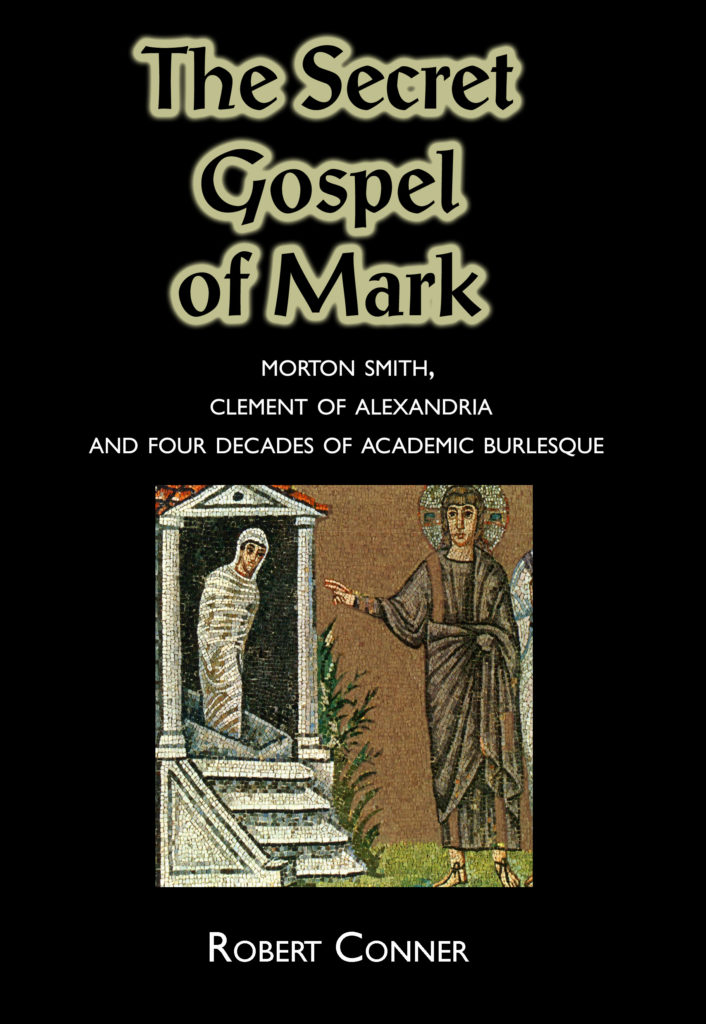
Morton Smith, Clement of Alexandria
and four decades of academic burlesque
Robert Conner
The Secret Gospel of Mark
Morton Smith, Clement of Alexandria
and four decades of academic burlesque
Robert Conner
Format: Softcover/160 pp.
ISBN: 978-1-906958-68-8
£15.00+p&p / US $24.00+p&p
Subjects: Religious Studies/Spirituality
Click HERE for USA
Click HERE for the UK Edition
While cataloguing material in the library of the monastery of Mar Saba in 1958, Morton Smith discovered a quotation from a letter of Clement of Alexandria copied in the end pages of a 17th-century collection of the letters of Ignatius. After more than a decade of a collaborative analysis of the find, Smith published his conclusions in 1973, setting off a firestorm of controversy in the New Testament studies guild.
In 1975, a Jesuit scholar, Quentin Quesnell, claimed the letter had been forged and implied that Smith was the forger, moving the focus of debate off the text itself and onto Smith. Since then the pages containing the letter have been removed from the book and possibly destroyed, while Catholic and evangelical writers, none of whom have ever seen the pages in question, continue to claim that Smith forged the letter.
Following his death in 1991, accusations against Smith took on a considerably more personal tone, highlighting his alleged homosexuality and by implication his dishonesty and moral perversity. Although the question of authenticity remains unresolved, the controversy has opened a window on the intellectually corrupt nature of apologetic New Testament studies, a subject of greater importance than the authenticity of early Christian texts.
The Dionysian Spirit
Featured
Sean Fitton
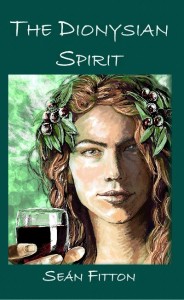
The Dionysian Spirit
Sean Fitton
Format: Softcover
ISBN: 978-1-906958-65-7
£15.00 / US$24.00
Subjects: Ancient Greece/
Greek Mysteries/Myths/Magic/Paganism/Spirituality.
Click Here for The Dionysian Spirit / USA
Click here for Kindle UK edition
Click Here for The Dionysian Spirit / UK
Click here for the Kindle USA edition
Dionysos is an obscure Greek god of wine and theatre for many people. For others, he is so much more.
The Dionysian Spirit examines the essence of what Dionysos is all about, both as a deity and as a cultural and social force. It looks at the relation of Dionysos with his opposite number Apollo. The twin gifts of Apollo and Dionysos are ekstasis (ecstasy) and entheos (enthusiasm) and have informed and enlivened our lives and cultures from ancient times right to the present day and beyond.
The Dionysian Spirit – like the art of a good party – has always been with us and now, in many ways, we need it more than ever.
Contents: Devotional to Dionysos / The Visualisation / The Myths of Dionysos / Dionysian Heroes / Dionysos Around the World / Dionysos Across The Millenium / Dionysos Goes Forth
Sacred Mountains
Featured
Stories of The Mystic Mountains
An Anthology
Michael Berman

Sacred Mountains
Stories of The Mystic Mountains
An Anthology
Michael Berman
Format: Softcover
ISBN: 9781906958220
£15.00 / US$24.00
Subjects: Shamanism/Mysticism/Spirituality/Myths & Legends.
Click HERE for Sacred Mountains / USA
Click HERE for Sacred Mountains /UK
On the mountains of truth, you can never climb in vain: either you will reach a point higher up today, or you will be training your powers so that you will be able to climb higher tomorrow.
~ Friedrich Nietzsche
What mountains mean to me: in one word, awe-inspiring. Although we can measure them, our minds are incapable of actually grasping the very small or the very large things in nature: neither atomic particles nor astronomical distances. How big is a mountain, how much does it weigh? Our limited minds can only cope with subjective assessments such as how difficult is it to climb, how dangerous would an avalanche be? So the feelings it produces are awe, a little fear, and possibly exhilaration if and when we think that we have conquered the mountain – but in reality we never can.
~ Professor David Hunt
All the stories presented in this collection contain shamanic elements, so the obvious starting point is to explain what is meant by this. The term ‘shaman’ is a controversial one. Initially employed by early anthropologists to refer to a specific category of magical practitioners from Siberia, the term is now widely used to denote similar practitioners from a variety of cultures around the world. This application of an originally culture-specific term to a more general usage has caused problems with regard to definition, with disagreements among scholars over whether certain features, such as soul flight or possession, or certain types of altered states of consciousness, should or should not be listed among the core characteristics of shamanism.
(Wilby, 2011, p.252.)
Introduction
What are Mountains for you?
Soul Captivation on White Bone Mountain
The Magic Brush and the Golden Mountain
The Legend of Amirani
The Story of Jumping Mouse
The Children of Hamelin: A Shamanic Journey into Mount Poppenberg
The Crystal Clear Waters of Mount Elbruz
The Vision Quest, Mount Sinai, and a Dream Fulfilled
Mount Ararat
Mount Koya-san, the Hermit’s Cave, and Fujiyama
Sacred Towers
The Fool on the Hill and the Book of Mysteries
The Tobacco of Harisaboqued
The Princess of the Tower
Appendix:
The Baal Shem Tov –
Rabbi, Religious Formulator or Shaman?
***
cover photograph by Joe Page shows Rennes Le Château seen from castle of Rennes Les Bains.
—
Launch 17th of January 2012 at the Georgian Embassy the author will talk about this book and give a reading. Starting promptly at 7.30 pm. The event is free and Georgian wine will be served at no cost too. The address is 4 Russell Gardens, West Kensington, London W14 8EZ. The hall holds about 60 people and we are hoping for a full house.
—
*************************************************************************************
RESOURCES FOR THE SACRED MOUNTAINS EXPERIENCE
Arts & Culture, Folklore, Myths & Legends, Food & Drink.
*************************************************************************************
Tbilisi Opera & Ballet Theatre
www.opera.ge
*
Georgia Cradle of Wine
www.georgia.gov.ge/5225
*
TAMADA,
Authentic Georgian Restaurant,
122 Boundary Road, St John’s Wood,
London NW8 0RH, UK.
www.tamada.co.uk
*
A Contemporary Western Book Of The Dead
Featured
An Anthology
Edited by Charlotte Rodgers & Lydia Maskell
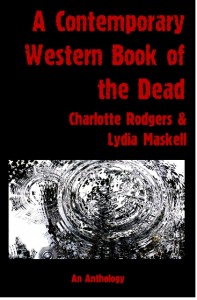
A Contemporary Western Book of The Dead
An Anthology
Edited by Charlotte Rodgers & Lydia Maskell
Format: Softcover
ISBN: 978-1-906958-04-6
£15.00 +P&P / US$22+P&P
Click HERE for UK edition
Click HERE for USA & Elsewhere
Click here for Kindle UK Edition
Click here for Kindle USA edition
‘I was musing on Singapore in all its affluent glory still having shrines for the dead on every street corner during ‘The Festival of the Hungry Ghosts’. Then I was musing on how the socially mobile of modern western society eschew death rites and grieving in the name of ‘holding it together’ and being progressive. I thought of which civilizations are falling and which are rising again, and wondered whether acknowledging death and the ancestors is a vital part of a maintaining personal identity and our place in society. I remember how my grieving father mourned for all the information he had relied on his deceased wife remembering; information which was now lost. I recalled Michael Crichton’s words ‘If you don’t know (your family’s) history, then you don’t know anything. You are a leaf that doesn’t know it is part of a tree.’
Then I thought maybe someone should write about the cults of the ancestors and death, perhaps an anthology, perhaps cross relate experiences of loss to personal spirituality and magick and history. I know that years of working with the dead in the name of art and spirituality, didn’t prepare me for the death of my mother. What helped me was the advice of someone from a long tradition of working with the ancestors. I think that collecting the experiences of spiritual practitioners in their working with grief and death is part of a living and necessary tradition that will give respect to the dead and strength, identity and support to our own personal spirituality.’
Within this book are rituals, stories, traditions and experiences of magicians’ scholars and artists who work with death. Some of the contributors such as Nema, Mogg Morgan, Louis Martine and Nevill Drury (to name but a few) have helped define contemporary transformative spirituality. Others are less well known but just as learned. As there should be in such a collection there is comedy, anger confrontation and practicality. This anthology is about who we are, and where we come from. It is also about how we change. A Contemporary Western Book of the Dead contains voices and visions that acknowledge our past, feed our present and guide the direction of our future.
Introduction/Charlotte Rodgers
Loved One/Nema
All a Do about Death /Josephine McCarthy
Clans For The Memory / Sarah Grimstone
Learning About Death / Nevill Drury
A Thoughtful Wake / Louis Martinie
Break On Through To The Other Side /Louise Hodgson
Death the Final Frontier / Sue Fox
The Bardo Thodol – Bon Voyage / John Power
You Only Live Twice / Ode bi Tola
On Speaking with the Dead: The Cult of the Dead in Traditional Culture / Michael Clarke
Body / Mishlen Linden
The Great Western Hoax / Ode bi Tola
The Book of Gates: A prose arrangement / Mogg Morgan
Biographies of Contributors
Photographers:
Sue Fox, Ruth Kenyon, Ariadne Spyridonos Xenou (Cover: Gerald Hutton)
Merlin’s Mound
Nigel Bryant
(Magical Fiction)
(Arthurian Myths & Legends)
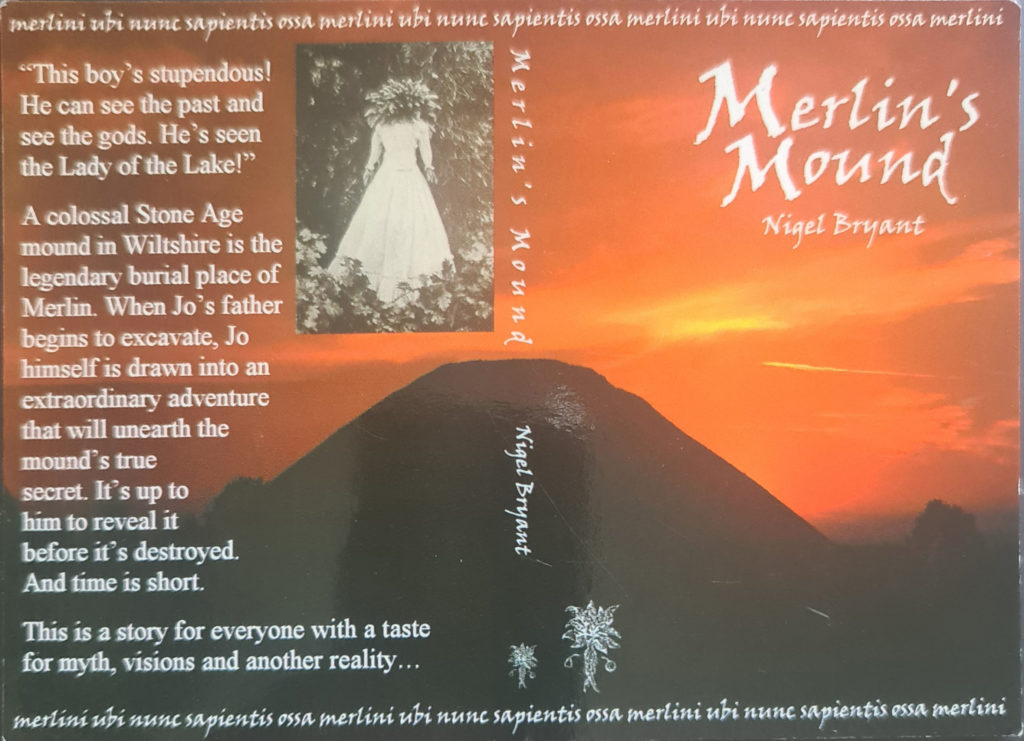
Merlin’s Mound
Nigel Bryant
Format: Softcover
£10.00/US$15.00
Subjects: Magical Fiction/Grail & Arthurian Myths & Legends/Spirituality.
“a wonderful book… in the same category as Alan Garner and Susan Cooper” Professor Ronald Hutton
‘This boy’s stupendous! He can see the past and see the gods. He’s seen the Lady of the Lake!’
A colossal Stone Age mound in Wiltshire is the legendary burial place of Merlin. When Jo’s father begins to excavate, Jo himself is drawn into an extraordinary adventure that unearths the mound’s true secret. It’s up to him to reveal it before it’s destroyed. And time is short.
‘A week ago he’d have laughed at this. Now he’s on the edge of a whole new world.’
This is a story for everyone with a taste for myth, visions and another reality…
About the book:
The Stone Age monuments at Avebury in Wiltshire are world-famous, attracting thousands of visitors each year. Two of the most dramatic are the enormous burial chamber known as the West Kennet Long Barrow, and Silbury Hill, the largest man-made mound in Europe. Less well known is Silbury’s “sister” mound at Marlborough a few miles due east, but this is nothing less than the legendary burial place of Merlin.
These extraordinary sites are the key locations of the novel Merlin’s Mound. In the novel, an adolescent is awakened startlingly to the meaning and original purpose of these locations. This story will appeal to everyone from the protagonist’s age and older who enjoys myth, legend, and visions. Marlborough is surely the only town in Britain with an Arthurian motto – “WHERE NOW ARE THE BONES OF WISE MERLIN”
REVIEWS
From Dragon’s Wood Magazine:
‘Meet Joel (Jo). He’s a nice lad. He likes football, he misses his mother (who is no longer with his dad), and he has the misfortune to have an obsessive and arrogant archaeologist for his father. Jo’s dad takes him on a dig in Marlborough Wiltshire to excavate what is locally known been as Merlin’s Mound. Jo really doesn’t want to be there, he would rather be watching football or playing computer games. Indeed he calls Silbury Hill ‘another pile of prehistoric pointlessness’. Jo’s relationship with his father is fraught at best and certainly not helped by some of the comments his father makes to his son.
Things start to happen…
Jo meets Dag, Gareth and Mort, three enigmatic characters who will play an interesting role as the story unfolds. Joe starts to realise that things are happening, things that he has no explanation for, things that will cause him to question and wonder. As time goes on Jo is more and more against the excavation of the Mound. He ‘knows’ that below the ground something or someone is still in residence. Is it Merlin? His father is convinced that the Marlborough site is a burial mound of someone pretty special and that somewhere in the mound four and a half thousand-year-old treasure is waiting for him to get his grasping hands on. He doesn’t subscribe to the Merlin theory, however. Jo on the other hand becomes more and more convinced that digging the mound is the wrong thing to do. It becomes his mission to reveal the true secret of the site and time is running out. What is that secret and ce of will Jo succeed?
Published by Mandrake of Oxford, Merlin’s Mound is listed on their website under the ‘young fiction’ genre. Certainly, the content of this book will appeal to teenagers. However that should not deter older readers. I found this both entertaining and interesting and certainly some light relief from all those other heavy books we pagans tend to read.
The author Nigel Bryant, whose involvement with Arthurian matters is long-standing and obvious from the way he writes, brings the reader a lively contemporary tale which often challenges our ideas on modern archaeology. I was left wondering whether or not digging up the past is always the right thing to do. This is the type of story that is great for us oldies to read on lazy summer afternoons in the back garden. Youngsters will no doubt identify with the often anxious adolescent that Jo is and I highly recommend it to anyone from about 15 years old. ‘
More reviews
Druid Network:
This is a book aimed at a ‘teenage’ audience, and it’s easy to see the central character appealing to many a surly teenager! But this the tale of a special teenager with special gifts, which link everyday events and archaeology – the never-ending search for scientific ‘truth’ and knowledge – to the sacred within and around us all, and to the sacred landscape of Wiltshire.
But it is a work that can be read and enjoyed by any age, the story is a timeless tale, one that holds the reader spellbound, fully involved with events and engaged with the participants. The monuments of Avebury and Merlin’s Mount at Marlborough come alive on the pages, and the less well known mound of Merlin Mount is central to the whole story, as the title suggests!
The tale is well written and flows beautifully and evocatively, pulling the reader in and giving real involvement with what is happening, and how the mystery will unravel. Highly recommended.
NIGEL BRYANT v DAN BROWN
MERLIN’S MOUND author Nigel Bryant appeared on ITV’s much-publicised programme The Grail Trail (25.9.05) to attack the vision of the Holy Grail in Dan Brown’s THE DA VINCI CODE.
“It may seem strange,” he says, “that I laid into Brown for using the Grail as a symbol of the womb, of the sacred feminine, when that very thing is central to MERLIN’S MOUND. But the difference is that I’m using it knowingly as a symbol. And I don’t claim that MERLIN’S MOUND is anything more (or less) than a story.”
“The trouble with Brown’s book is that it’s a prime example of a dire new literary genre of pseudo-fact. Unfortunately, in THE DA VINCI CODE Dan Brown has swallowed hook, line and sinker the central thesis of a best-seller of two decades ago – The Holy Blood and the Holy Grail – which can be demolished in 30 seconds. ”
“The theory depends entirely on a mistake caused by astonishingly sloppy scholarship. The play on words by which the SANGREAL (the Holy Grail) is supposedly a code for SANG-REAL (‘royal blood’) – leading on to the hilarious notion (after all, let’s just stop and think about it for a second) that a child born of Jesus and Mary Magdalene was the start of a bloodline which kept going in secret for 2,000 years – simply doesn’t work. Dan Brown lists a series of ‘facts’ at the start of his book; well here’s a fact he doesn’t mention: the spelling SANGREAL doesn’t exist in any French work. It’s a pun that works only in French, but no French writer ever used it. In French it’s invariably written SAINT GRAAL. The only person who ever did write SANGREAL was the 15th-century Englishman John Hardyng whose French wasn’t very good, so he heard ‘saint graal’, didn’t know how to spell it, had a guess and wrote ‘sangreal’. And on that simple mistake, almost akin to a typing error, is the whole wild theory based.”
“I’ve no problem with it, actually – the Mary Magdalene / bloodline of Christ idea’s a fun story – but claiming it (and other supposed ‘facts’ in Dan Brown’s book) to be ‘true’ is sad in the extreme. We’ve got to be able to distinguish fact from fiction. Pseudo-fact does no favours either for fiction or for history or, for that matter, for the world of symbols.”
“I’m seriously interested in the medieval Grail stories – hence my book The Legend of the Grail [Boydell & Brewer, 2004], which brings together the eight great French grail romances of the 12th and 13th centuries and creates from them a single, coherent narrative. Womb imagery is nowhere to be seen. But that doesn’t mean I can’t use the Grail’s potential symbolism and work it into a story of the sacred feminine in MERLIN’S MOUND. But I’m not going to do a Dan Brown and claim it to be ‘true’ in the sense of being a ‘fact’. Let’s all grow up a bit. The Grail doesn’t exist and never did. But it’s there even though it’s not there. It’s absolutely ‘true’, profoundly ‘true’, when you take it as a symbol.”
The Wanton Green
Edited by Gordon MacLellan
& Susan Cross
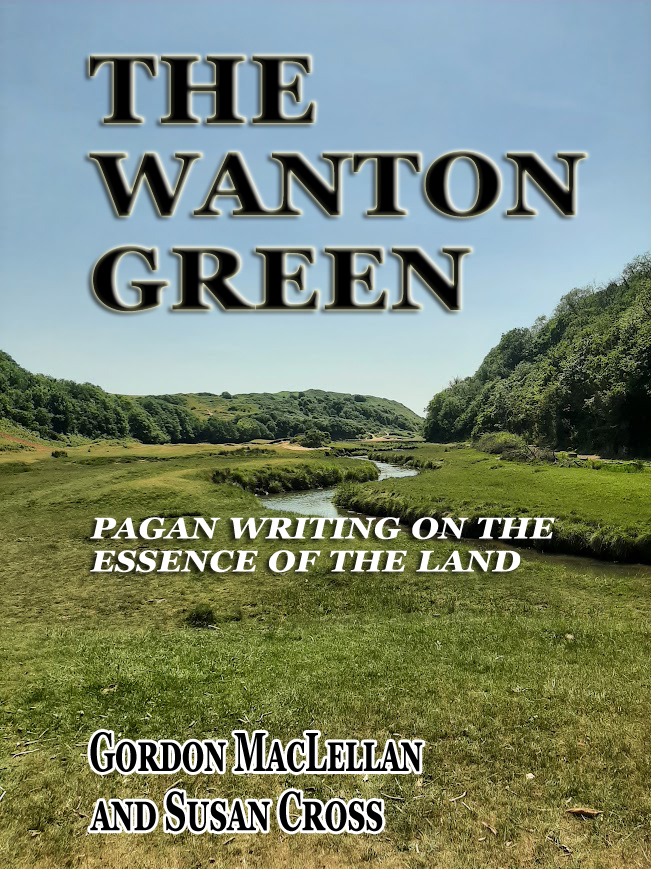
The Wanton Green
Edited by Gordon MacLellan & Susan Cross
Format: Softcover
ISBN:
£14.99 / US$23.00
Subjects: Contemporary Pagan Writings/Paganism/Spirituality.
Click Here for The Wanton Geen / USA
Click Here for The Wanton Green / UK
As our relationship with the world unravels and needs to take a new form, The Wanton Green presents a collection of inspiring, provoking and engaging essays by modern pagans about their own deep, passionate and wanton relationships with the Earth.
“Where do we locate the sacred? In a place, a meeting, memory, a momentary glimpse? The Wanton Green provides no easy answers and instead, offers a multitude of perspectives on how our relationships with the earth, the sacred, the world through which we move are forged and remade.” – Phil Hine.
About the editors:
Gordon MacLennan is a shaman, storyteller and artist whose work sets out to find ways of celebrating the relationships between people, place and wildlife. Gordon’s books include Talking to the Earth, Sacred Animals and Celebrating Nature (all with Capall Bann), StarMatter and the Piatkus Guide to Shamanism.
Susan Cross is a poet, heritage and environmental interpretation consultant and occasional pirate. About a decade ago she realised that she has probably always been some kind of animist mystic and since then has endeavoured to make that a more conscious, clearer and brighter part of her life.
The Wanton Green: Contemporary Pagan Writings On Place. Edited by Gordon MacLellan and Susan Cross (Mandrake). Since the 1970s modern forms of pagan witchcraft (Wicca) and the neo-pagan movement have defined themselves by an engagement and involvement with ecology, the environment and ‘green’ politics with their adherents claiming to be following a ‘nature religion’. This is a collection of essays on the genii loci, or ‘spirit of place’ in the natural world written by various Wiccans and neo-pagans including Shani Oates, Rufus Harrington, Emma Restall-Orr, Melissa Montgomery, Jan Fries, Julian Vayne, Barry Montgomery, Barry Paterson, Susan Greenwood, Mogg Morgan and others. The contents range from an experience of the faery folk in Devon to a psychogeographical guide to ‘occult London’. If you are interested in the non-traditional neo-pagan approach to nature and the environment then this book is recommended. – The Cauldron #144, May 2012.
